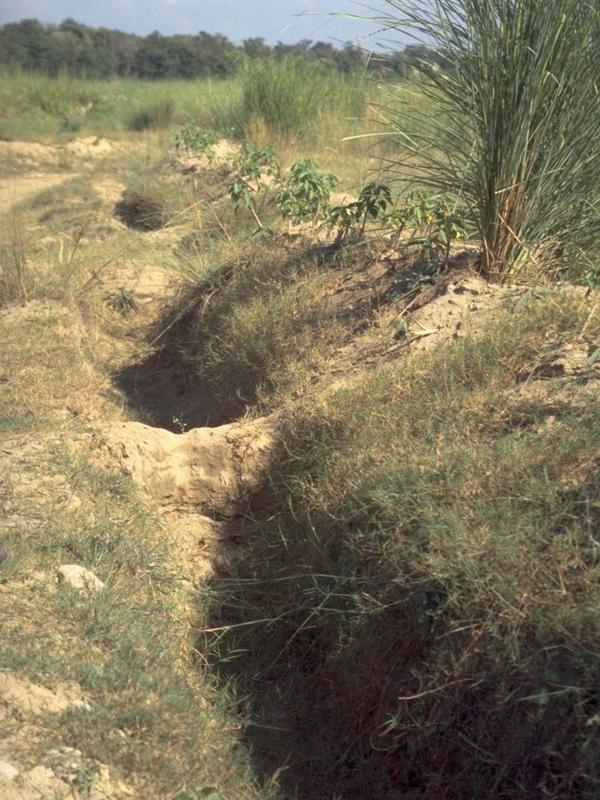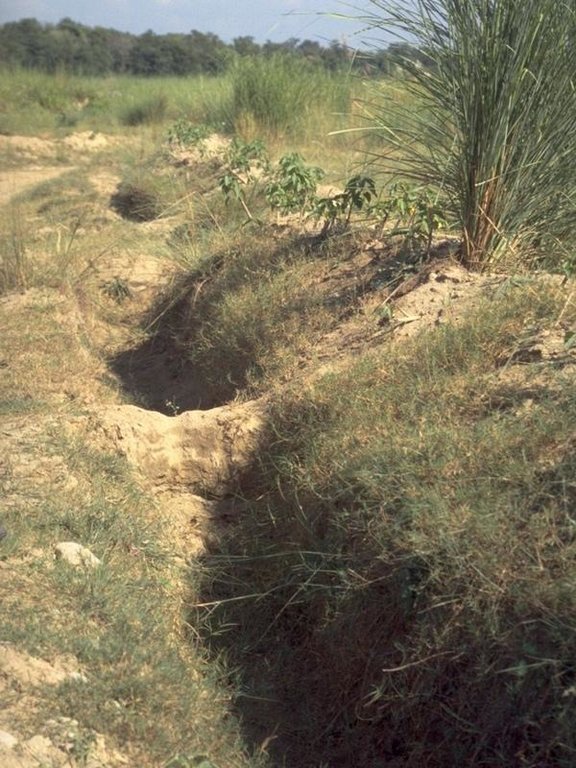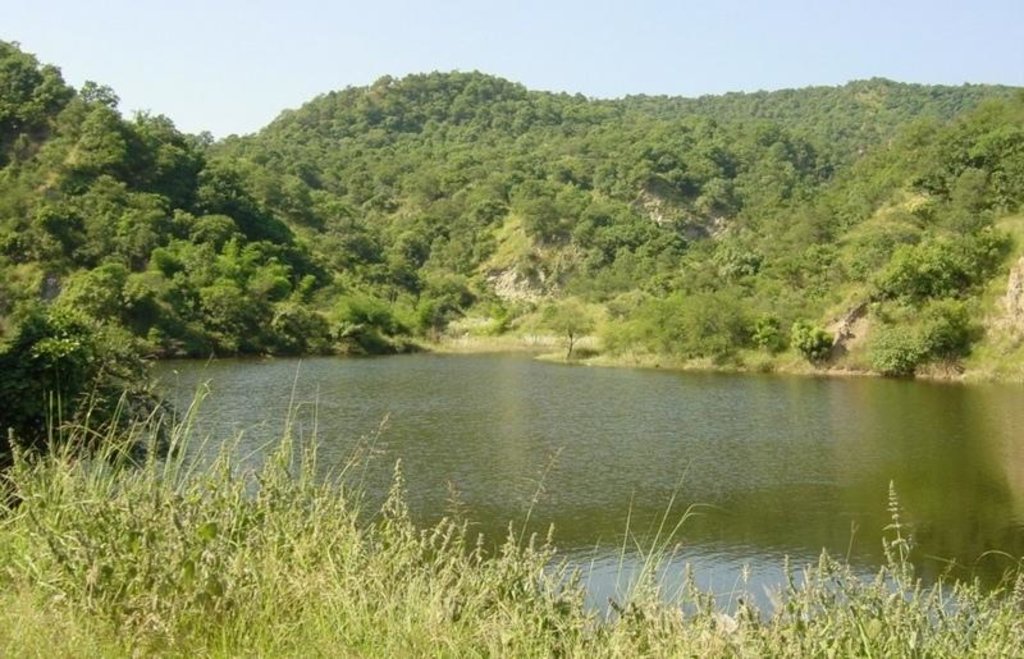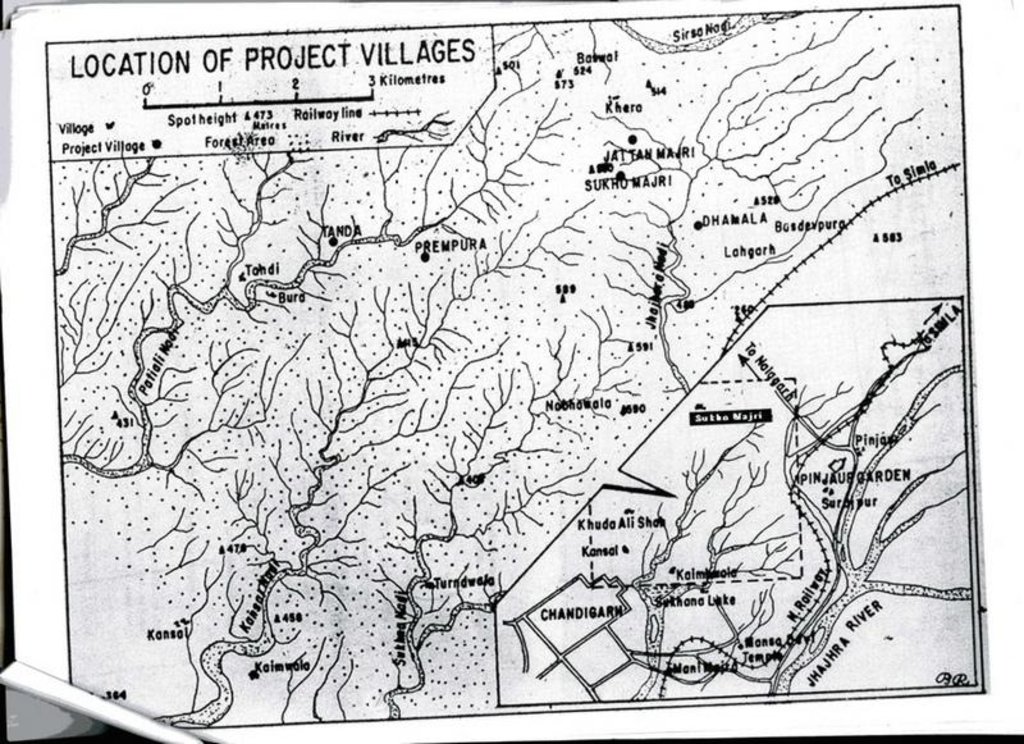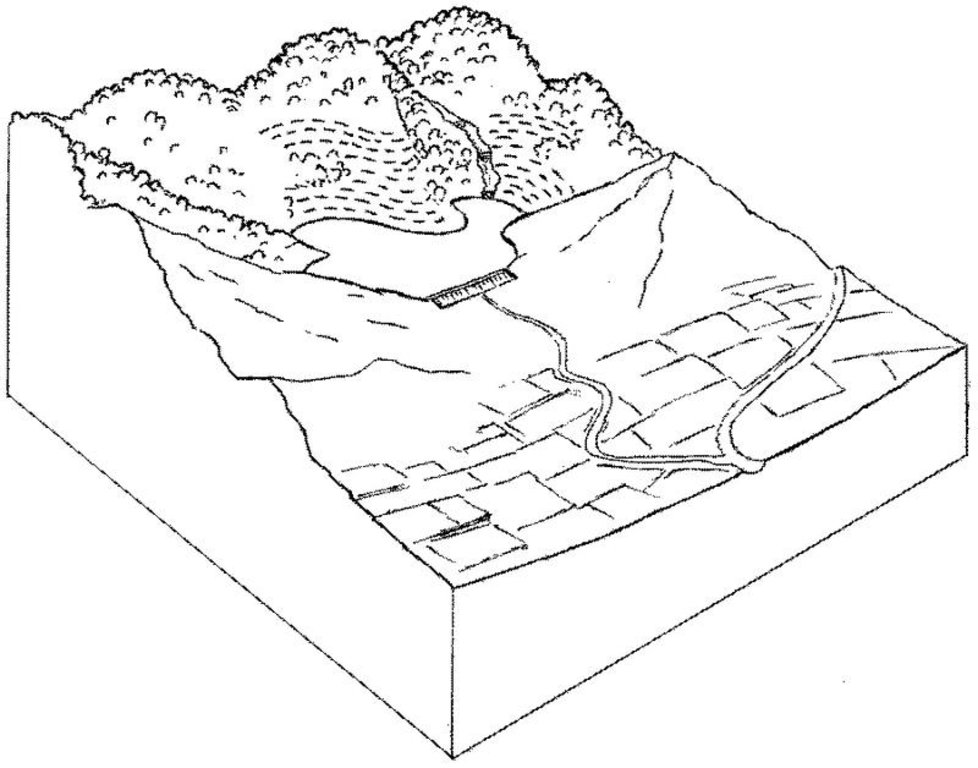Forest catchment treatment [印度]
- 创建:
- 更新:
- 编制者: Chetan Kumar
- 编辑者: –
- 审查者: Fabian Ottiger
technologies_1476 - 印度
查看章节
全部展开 全部收起1. 一般信息
1.2 参与该技术评估和文件编制的资源人员和机构的联系方式
SLM专业人员:
Vashisth US
01732-30006
usvashisth@teri.res.in
House No.1014 Sector 17 Jagadhari, Yamunanagar
印度
有助于对技术进行记录/评估的项目名称(如相关)
Book project: where the land is greener - Case Studies and Analysis of Soil and Water Conservation Initiatives Worldwide (where the land is greener)有助于对技术进行记录/评估的机构名称(如相关)
CIFOR Center for International Forestry Research (CIFOR) - 印度1.3 关于使用通过WOCAT记录的数据的条件
(现场)数据是什么时候汇编的?:
01/09/2002
编制者和关键资源人员接受有关使用通过WOCAT记录数据的条件。:
是
1.5 请参阅有关SLM方法的问卷

Joint forest management [印度]
Government and NGO supported community protection of forested catchments, through village-based Hill Resource Management Societies.
- 编制者: Sumana Datta
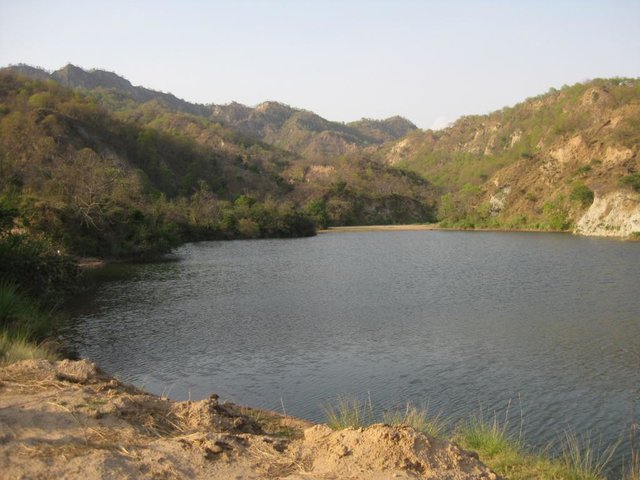
Joint forest management [印度]
Joint forest management is a community based program developed in collaboration with the forest department for the protection and management of local forests while providing incentives to the local communities with political and institutional support from the state.
- 编制者: Sumana Datta
2. SLM技术的说明
2.1 技术简介
技术定义:
Catchment treatment of degraded forest land including social fencing, infiltration trenches and enrichment planting with trees and grasses for production and dam protection.
2.2 技术的详细说明
说明:
Forest catchment treatment aims to achieve production and environmental benefits through a combination of structural, vegetative and management measures in badly degraded catchments above villages. These efforts are concentrated in the highly erodible Shiwalik Hills at the foot of the Himalayan range where soil erosion has ravaged the landscape, and the original forest has almost disappeared.
The purpose of forest catchment treatment is first to rehabilitate the forest through protection of the area by ‘social fencing’ (villagers agreeing amongst themselves to exclude livestock without using physical barriers), then construction of soil conservation measures (staggered contour trenches, check dams, graded stabilisation channels etc; see establishment activities), and ‘enrichment planting’ of trees and grasses within the existing forest stand to improve composition and cover. These species usually include trees such as Acacia catechu and Dalbergia sissoo, and fodder grasses - as well as bhabbar grass (Eulaliopsis binata), which is used for rope making. The combined measures are aimed at reestablishing the forest canopy, understorey and floor, thereby restoring the forest ecosystem together with its functions and services. Biodiversity is simultaneously enhanced.
The second main objective is to provide supplementary irrigation water to the village below through construction of one, or more, earth dams. The village community - organised into a Hill Resource Management Society - is the source of highly subsidised labour for forest catchment treatment. After catchment protection around the proposed dam site(s), the dam(s) and pipeline(s) are constructed. The dams are generally between 20,000 and 200,000 m3 in capacity, and the pipelines usually one kilometre or less in length.
Apart from irrigation, the villagers benefit from communal use of non-timber forest resources. Forest catchment treatment (associated with the approach termed ‘joint forest management’ - JFM) has been developed from a pilot initiative in Sukhomajri village in 1976, and has spread very widely throughout India. This description focuses on Ambala and Yamunanagar Districts in Haryana State.
The Shiwalik hills where the SWC technology was applied is one of the eight most degraded, rainfed agro-ecosystems of India. It is highly erodible, with presence of low water retentive soils and severe soil erosion, haing water scarcity despite average 1000 mm annual rainfall.
2.3 技术照片
2.5 已应用该技术的、本评估所涵盖的国家/地区/地点
国家:
印度
区域/州/省:
Haryana
有关地点的进一步说明:
Ambala and Yamunanagar
Map
×3. SLM技术的分类
3.1 该技术的主要目的
- 改良生产
- 减少、预防、恢复土地退化
3.2 应用该技术的当前土地利用类型

牧场

森林/林地
- Rehabilitated natural forest
注释:
Major land use problems (compiler’s opinion): The Shiwalik Hills are extremely prone to both surface erosion and landslides, and general degradation of vegetation due to over-exploitation. Some areas have become completely denuded because of overgrazing and woodcutting. Furthermore there is no, or inadequate, water for irrigation of crops.
Grazingland comments: Due to free grazing, much of the forest land was becoming barren and fodder yield declined over a period of time. The average fodder yield was about two quintals/ha of forest land and fodder consumption was 26.69kg/animal/day.
Problems / comments regarding forest use: Tree species like Khaci (Acacia catechu), Dalbergio sissoo in pits and slips of bhabbar grass (Eulaliopsis binata) on mounds of trenches and hill slopes were planted. Bhabbar grass was sold out by forest department to contractors.
Type of grazing system comments: Due to free grazing, much of the forest land was becoming barren and fodder yield declined over a period of time. The average fodder yield was about two quintals/ha of forest land and fodder consumption was 26.69kg/animal/day.
3.3 有关土地利用的更多信息
具体说明:
Longest growing period in days: 120 Longest growing period from month to month: Jul - Oct
3.4 该技术所属的SLM组
- 区域封闭(停止使用,支持恢复)
- 改良的地面/植被覆盖
- 横坡措施
3.5 技术传播
注释:
Total area covered by the SLM Technology is 198 m2.
3.6 包含该技术的可持续土地管理措施
3.7 该技术强调的主要土地退化类型

土壤水蚀
- Wt:表土流失/地表侵蚀
- Wg:冲沟侵蚀/沟蚀
- Wm:块体运动/滑坡

水质恶化
- Ha:干旱化
注释:
Main type of degradation addressed: Wt: loss of topsoil / surface erosion
Secondary types of degradation addressed: Wg: gully erosion / gullying, Wm: mass movements / landslides, Ha: aridification
Main causes of degradation: deforestation / removal of natural vegetation (incl. forest fires), education, access to knowledge and support services (Absence of institutional arrangements to disseminate the knowledge from lab to land and involve the users in implementation)
Secondary causes of degradation: overgrazing (Subsistence economy, dependance on forests for fuelwood and fodder, livestock were low quality, free grazing type. And these were no regulatory mechanisms to share usufruct from forests with people.), poverty / wealth (Lack of capital at the grassroot to take the initiative by the farmers themselves)
3.8 防止、减少或恢复土地退化
具体数量名该技术与土地退化有关的目标:
- 减少土地退化
4. 技术规范、实施活动、投入和成本
4.1 该技术的技术图纸
4.2 技术规范/技术图纸说明
Forest catchment treatment: an overview showing protected forest, dam and irrigated cropland below.
Technical knowledge required for field staff / advisors: moderate
Technical knowledge required for land users: moderate
Main technical functions: increase of infiltration, water harvesting / increase water supply
Secondary technical functions: control of dispersed runoff: retain / trap, improvement of ground cover, control of concentrated runoff
Vegetative measure: enrichment planting with
Vegetative material: T : trees / shrubs, G : grass
Vegetative measure: Vegetative material: T : trees / shrubs, G : grass
Vegetative measure: Vegetative material: T : trees / shrubs, G : grass
Vegetative measure: Vegetative material: T : trees / shrubs, G : grass
Trees/ shrubs species: Acacia catechu, Dalbergia sissoo etc
Grass species: bhabbar grass: Eulaliopsis binata
Structural measure: dam
Structural measure: trenches
Structural measure: ditches
Structural measure: check dams
Other type of management: social fencing
4.4 技术建立活动
| 活动 | 措施类型 | 时间 | |
|---|---|---|---|
| 1. | Enrichment planting of tree seedlings (Acacia catechu, Dalbergiasissoo etc), grasses (bhabbar grass: Eulaliopsis binata) on bundsof earth and hill slopes, and Ipomea cornea in channels. | 植物性的 | beginning of the monsoon rains. |
| 2. | Construction of a series of staggered contour trenches on slopes. | 结构性的 | pre-monsoon |
| 3. | Construction of stone/earth/wood check dams in gullies. | 结构性的 | pre-monsoon |
| 4. | Construction of graded stabilisation channels which capture runoffand discharge it safely. | 结构性的 | pre-monsoon |
| 5. | Construction of earth dam wall for water harvesting and concretepipelines for irrigation. | 结构性的 | pre-monsoon |
| 6. | Introduction of social fencing system through Hill ResourceManagement Societies. | 管理 | pre-monsoon |
4.5 技术建立所需要的费用和投入
| 对投入进行具体说明 | 单位 | 数量 | 单位成本 | 每项投入的总成本 | 土地使用者承担的成本% | |
|---|---|---|---|---|---|---|
| 劳动力 | Labour | ha | 1.0 | 250.0 | 250.0 | 5.0 |
| 设备 | Machine use | ha | 1.0 | 75.0 | 75.0 | |
| 植物材料 | Seedlings | ha | 1.0 | 50.0 | 50.0 | |
| 施工材料 | Construction material for dam wall | ha | 1.0 | 25.0 | 25.0 | |
| 技术建立所需总成本 | 400.0 | |||||
注释:
Duration of establishment phase: 36 month(s)
4.6 维护/经常性活动
| 活动 | 措施类型 | 时间/频率 | |
|---|---|---|---|
| 1. | watch and ward | 植物性的 | /on-going |
| 2. | Desilting of water harvesting structures. | 结构性的 | pre-monsoon,/once every year |
| 3. | Repair of channels. | 结构性的 | pre-monsoon,/once every year |
| 4. | Maintenance of structures. | 结构性的 | pre-monsoon,/ |
| 5. | regular meetings/facilitations | 管理 | |
| 6. | control grazing fines, peer-group pressure | 管理 |
4.7 维护/经常性活动所需要的费用和投入(每年)
| 对投入进行具体说明 | 单位 | 数量 | 单位成本 | 每项投入的总成本 | 土地使用者承担的成本% | |
|---|---|---|---|---|---|---|
| 劳动力 | Labour | ha | 1.0 | 50.0 | 50.0 | 95.0 |
| 技术维护所需总成本 | 50.0 | |||||
注释:
This information is indicative and is based on calculations derived from Thaska village (Yamunanagar District)
where there are 3 dams - collecting the runoff from the total forest catchment of 75 ha. The cost range of treatments per
hectare of rehabilitated forest is generally US$ 200–700 (where the main cost is that of the dam construction) and typically the area of supplementary irrigation (command area) is twice as large as the forest catchment treated (in this case the irrigated area is 150 ha).
Cost per unit: the treatment of a 25 ha unit of catchment including construction of a dam costs around US$ 10,000.
5. 自然和人文环境
5.1 气候
年降雨量
- < 250毫米
- 251-500毫米
- 501-750毫米
- 751-1,000毫米
- 1,001-1,500毫米
- 1,501-2,000毫米
- 2,001-3,000毫米
- 3,001-4,000毫米
- > 4,000毫米
农业气候带
- 半湿润
- 半干旱
Semi arid: Shiwalik region falls under semi-arid agro-climatic zone.
5.2 地形
平均坡度:
- 水平(0-2%)
- 缓降(3-5%)
- 平缓(6-10%)
- 滚坡(11-15%)
- 崎岖(16-30%)
- 陡峭(31-60%)
- 非常陡峭(>60%)
地形:
- 高原/平原
- 山脊
- 山坡
- 山地斜坡
- 麓坡
- 谷底
垂直分布带:
- 0-100 m a.s.l.
- 101-500 m a.s.l.
- 501-1,000 m a.s.l.
- 1,001-1,500 m a.s.l.
- 1,501-2,000 m a.s.l.
- 2,001-2,500 m a.s.l.
- 2,501-3,000 m a.s.l.
- 3,001-4,000 m a.s.l.
- > 4,000 m a.s.l.
关于地形的注释和进一步规范:
Landforms: Hill slopes (ranked 1, Higher hills are located in the northern and eastern part of the tract, while low hills in the southern and western parts of the tract. These hills are characterized by relatively high intensity of er), ridges (ranked 2) and footslopes (ranked 3)
Slopes on average: Moderate (ranked 1, the slopes vary considerably from moderate to precipitous), hilly (ranked 2) and steep (ranked 3)
5.3 土壤
平均土层深度:
- 非常浅(0-20厘米)
- 浅(21-50厘米)
- 中等深度(51-80厘米)
- 深(81-120厘米)
- 非常深(> 120厘米)
土壤质地(表土):
- 粗粒/轻(砂质)
表土有机质:
- 中(1-3%)
- 低(<1%)
如有可能,附上完整的土壤描述或具体说明可用的信息,例如土壤类型、土壤酸碱度、阳离子交换能力、氮、盐度等。:
Soil depth on average: Also shallow (ranked 2) and deep (ranked 3)
Soil texture: Coarse (ranked 1, in most of the areas soils are sandy. However sandy loam, loamy sand and sill loam soils are also met with), medium (ranked 2) and fine/heavy (ranked 3)
Soil fertility: Medium (soils are deficient in humus contents. However soils are fairly fertile and suitable for raising forest crops in the entire area)
Soil drainage/infiltration: Poor (water holding capacity of soils is good)
5.6 应用该技术的土地使用者的特征
生产系统的市场定位:
- 生计(自给)
- 混合(生计/商业
非农收入:
- 收入的10-50%
说明土地使用者的其他有关特征:
Off-farm income specification: significant off-farm activity/income includes rope making from bhabbar grass. Sale of fodder grass from the forest provides
additional income.
Market orientation forest land: Mixed (forest dept. used to give annual contracts for bhabbar grasses)
5.7 应用该技术的土地使用者拥有或租用的平均土地面积
- < 0.5 公顷
- 0.5-1 公顷
- 1-2 公顷
- 2-5公顷
- 5-15公顷
- 15-50公顷
- 50-100公顷
- 100-500公顷
- 500-1,000公顷
- 1,000-10,000公顷
- > 10,000公顷
注释:
2-5 ha: Grazing land mainly comprises of forest area where villagers have rights, private as well as community lands.
5.8 土地所有权、土地使用权和水使用权
土地所有权:
- 州
土地使用权:
- 社区(有组织)
6. 影响和结论性说明
6.1 该技术的现场影响
社会经济效应
生产
饲料生产
饲料质量
木材生产
产品多样性
注释/具体说明:
Increased non-timber forest products
收入和成本
农业收入
经济差异
注释/具体说明:
Those with irrigation vs those without
社会文化影响
社区机构
SLM/土地退化知识
冲突缓解
注释/具体说明:
Those with irrigation vs those without
生态影响
土壤
土壤水分
土壤覆盖层
土壤流失
生物多样性:植被、动物
植被覆盖
注释/具体说明:
Trees and grass
植物多样性
动物多样性
栖息地多样性
6.2 该技术的场外影响已经显现
旱季稳定可靠的水流
下游洪水
下游淤积
Crop yield
注释/具体说明:
From new irrigation water
6.4 成本效益分析
技术收益与技术建立成本相比如何(从土地使用者的角度看)?
短期回报:
非常积极
长期回报:
非常积极
技术收益与技术维护成本/经常性成本相比如何(从土地使用者的角度看)?
短期回报:
非常积极
长期回报:
非常积极
6.5 技术采用
在所有采用这项技术的人当中,有多少人是自发地采用该技术,即未获得任何物质奖励/付款?:
- 50-90%
注释:
40% of land user families have adopted the Technology with external material support
Comments on acceptance with external material support: estimates
60% of land user families have adopted the Technology without any external material support
There is a strong trend towards spontaneous adoption of the Technology
Comments on adoption trend: The spread of such forest treatment within Haryana (and outside) is happening steadily.
Farmers have levelled theor fields to await water for irrigation from dams. The villagers have also contributed by money/labour in lying pipelines for water distribution.
6.7 该技术的优点/长处/机会
| 土地使用者眼中的长处/优势/机会 |
|---|
|
Increased availabilzy of fodder and fuel. How can they be sustained / enhanced? Improvement in livestock mix and breed owned by villlagers. |
|
Increased crop yields, milk production and horticultural products How can they be sustained / enhanced? Suitable crop mix to derive maximum benefits from water from dams |
| 编制者或其他关键资源人员认为的长处/优势/机会 |
|---|
|
Increased surface and groundwater help to fill the dam rather than running off and causing flooding and erosion lower down (but not always: see first off-site disadvantage) How can they be sustained / enhanced? Ensure continuous protection/ regular maintenance. |
|
Increased fodder and fuel from the renewed forest resources How can they be sustained / enhanced? Ditto. |
|
Reduction of runoff and erosion in the previously degraded catchment How can they be sustained / enhanced? Ditto. |
|
Improved forest conditions – both canopy and understorey delivering general ecosystem benefits How can they be sustained / enhanced? Ditto. |
|
Increased crop yield from irrigation made possible through irrigation from the dam Increased household income Increased community institution strength How can they be sustained / enhanced? Ditto. |
6.8 技术的弱点/缺点/风险及其克服方法
| 土地使用者认为的弱点/缺点/风险 | 如何克服它们? |
|---|---|
| Initial investment to change the cattle mix. | Arrangement of credit facility. |
| 编制者或其他关键资源人员认为的弱点/缺点/风险 | 如何克服它们? |
|---|---|
| In some cases reduction in runoff (because of increased vegetation) causes less water for irrigation | Manipulate vegetative cover as required (selective cutting). |
| Conflicts in water distribution | Conflict resolution may need to be carried out through Hill Resource Management Societies. |
| High labour input. | |
| Regular maintenance and desilting of earthen dams. |
7. 参考和链接
7.2 参考可用出版物
标题、作者、年份、ISBN:
Singh TP and Varalakshmi V: The Decade and Beyond: Evolving community-state partnership. TERI, New Delhi. 1998.
标题、作者、年份、ISBN:
Poffenberger M and McGean B (eds): Village Voices, Forest Choices. Joint Forest Management in India. Oxford University Press, Delhi. 1996.
链接和模块
全部展开 全部收起链接

Joint forest management [印度]
Government and NGO supported community protection of forested catchments, through village-based Hill Resource Management Societies.
- 编制者: Sumana Datta

Joint forest management [印度]
Joint forest management is a community based program developed in collaboration with the forest department for the protection and management of local forests while providing incentives to the local communities with political and institutional support from the state.
- 编制者: Sumana Datta
模块
无模块


